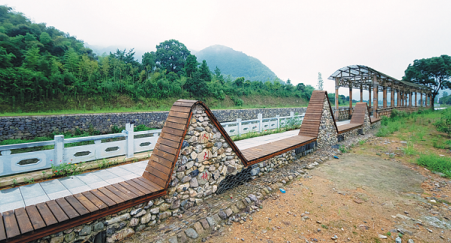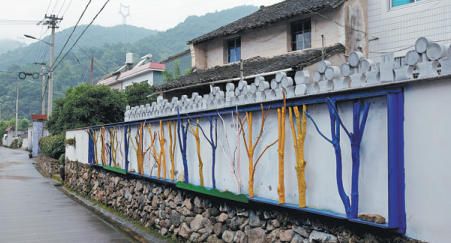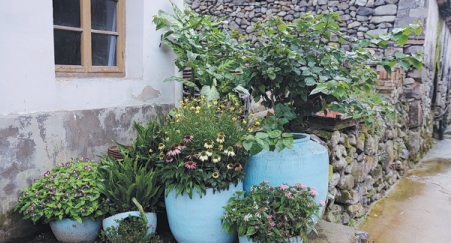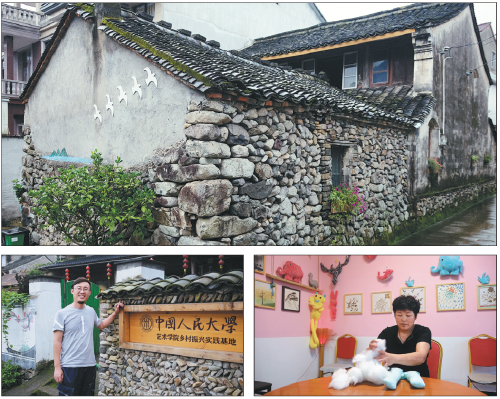Rural landscape gets 'face-lift'
Farmers work with a visiting art teacher to beautify their village, Ma Zhenhuan reports in Ninghai, Zhejiang province.

Gejia village in Ninghai county, East China's Zhejiang province, got a facelift after colors were added to houses there. Culture has played an important role in the country's rural-revitalization program.
President Xi Jinping said in a report to the 19th Communist Party of China National Congress: "We must develop a socialist culture with Chinese characteristics, inspire the cultural creativity of our whole nation and develop a great socialist culture in China."
Gejia, located in the northern part of the county in the coastal city of Ningbo, was a village with moderate development earlier. The majority of some 600 households made a living by farming. The idea that farmers could create art to improve the environment or make a living did not exist.
"The world of art and design was so up high and we couldn't imagine that one day, we farmers could reach it," says Ge Menghui, a 58-year-old villager.
Things changed after a visit to the village by Cong Zhiqiang, an associate art professor at Renmin University of China in Beijing, last April. He was looking to put his theory into practice and demonstrate it to his students, and Gejia came into his view for its "ordinariness".
Cong, who has worked on art and design for more than two decades, has been focusing on the role of ordinary people in renovating rural surroundings with art.
"In the industrial age, design was mainly used to create things. But today, I think design can also be applied to reshape farmers' way of life, the way they respond to their surroundings and the outside world. It empowers them when seeking changes in social relations," he says.
"I have learned of cases in Europe, Japan and South Korea where rural residents were involved in changes in their surroundings, and the changes were made more easily and effectively."
Cong received a warm response from local officials in Ninghai, who have actively supported him in turning the concept into reality.
"Once the theory proves effective here, it can be duplicated in many other Chinese villages," he says.
At first, Cong tried lecturing villagers about art design, but failed to generate any enthusiasm.
"They thought I was insane when I proposed that they make art themselves. Some of them said I was a fraud," Cong says.
He won the trust of the people by doing something for them first. After observing residents' activities for several days, he settled on making a bench using wood and rocks in an open area. It allowed residents to rest and chat. It soon ignited a desire for a better local living environment.
So far, more than 150 residents of Gejia have taken part in the art project, looking for places that need improving and thinking about the best approach. Cong and his students offer suggestions and advice.
Many designers use art to provide new looks in villages by plastering modern images on empty walls or by renovating the architecture. Cong found a way to beautify Gejia by giving full play to local residents' skills and guiding them to make artworks for the decoration of public spaces by themselves.
People who are good at needlework were encouraged to make fabric products such as cloth dolls and those adept at using bamboo or wood were told to design artistic decorations in their courtyards.
Today, when walking through the alleys in the village, almost all decorations at the corners, on walls and in public spaces are made by the residents, including flower pots, benches, lamps and pavilions. Local people are now a primary force in Gejia's environmental improvement.
Ye Xianrong, a 66-year-old resident, opened an art gallery by collecting and showcasing time-honored objects and artworks made by her family members and neighbors.
Ye says the gallery that bears her name is bringing more happiness to her life.
"I don't expect to earn money from the gallery. All I want is that visitors can admire ordinary people's artworks," she says.
Ge, who didn't agree with Cong's approach at first, is now an active participant in the art project."With the improvement of the village, more people are willing to join, which is making the environment even better."
The influence of art on Gejia went beyond Cong's expectations.
"I always believed that every person has artistic creativity, but I didn't know that rural farmers could be so creative and imaginative," he says.
Cong and his students spent less than two months in Gejia last year, but the art project continues without them.
"When we returned to Beijing, the villagers offered ideas in a WeChat group and we gave them advice about how to implement them,"Cong says, adding that the continuity proved that involving local residents in art designs could generate development from inside a village.
He says he will help the residents of Gejia develop and sell some distinctive products based on the local culture in future.
Cong's team will focus on the commercial development of tourist facilities in the village such as homestays, restaurants and entertainment spaces this year.
Qin Jirong contributed to the story





Today's Top News
- Xi chairs CPC leadership meeting on Party conduct, anti-corruption work
- Why Hainan Free Trade Port stands out
- Rule of law strengthens business environment
- Documents affirm one-China principle
- Central SOEs urged to push upgrading
- Agreement boosts ocean governance






























